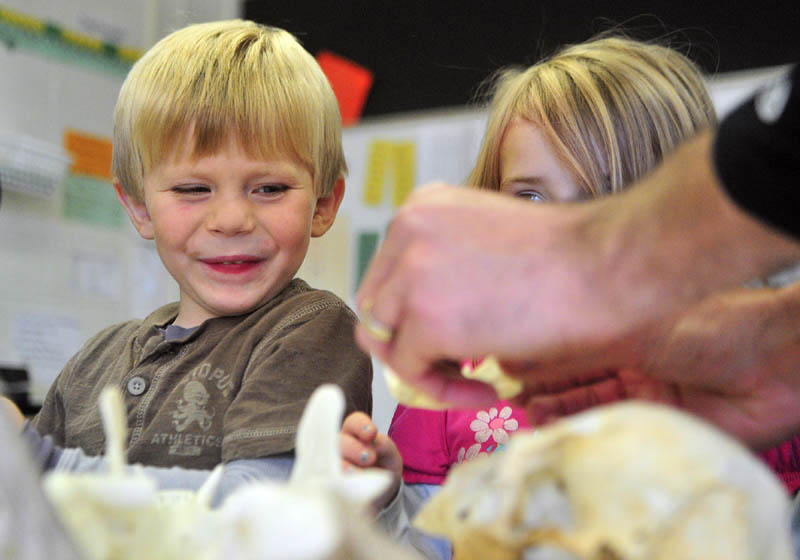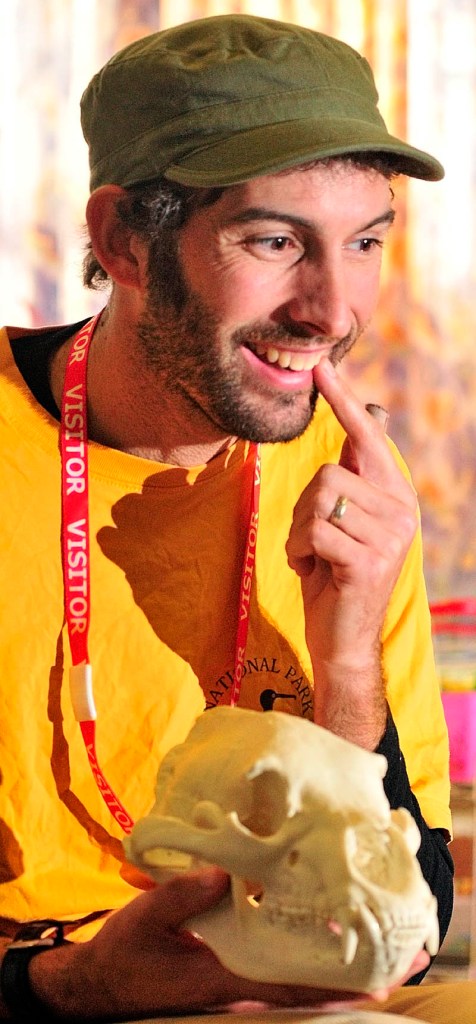AUGUSTA — Leigh Rose chose a skull from the table and held it up for Rita Clement’s pre-kindergarten students to see.
“Does anyone know whose skull this is?” Rose asked.
He provided a couple of hints. The eye sockets were on the skull’s sides — because the animal likes to hide, Rose said — and it had the flat teeth of an herbivore. Students made a few guesses.
“A dinosaur!” one boy said.
“A swordfish!” said another.
When Rose picked up an antler from the table and held it atop the skull, the students caught on: It was a deer.
At Gilbert Elementary on Wednesday, nearly 100 pre-kindergarten students learned what to call animals that eat meat or plants, how soft a skunk’s fur is and that a woodpecker’s tongue is so long it wraps partway around the bird’s skull.
Rose is an educator for the L.C. Bates Museum at Good Will-Hinckley, and his visit to Gilbert on Wednesday was the second of six weekly natural science presentations for the school’s youngest students.
A grant from the Institute of Museum and Library Science and a gift from Skowhegan Savings Bank are allowing museum educators to do similar presentations for preschoolers around the region, expanding on a few years’ worth of programs for second- and fourth-grade classes.
L.C. Bates Museum Director Deborah Staber said museum educators will visit 106 classrooms this year.
Some of the presentations are habitat-based, like the ones focused on forests that Rose gave on Wednesday. Others focus on Maine species within a specific group of animals, such as birds or fish.
The students at Gilbert had the chance to feel animal pelts, listen to bird calls and make nature-themed necklaces.
Evan Pitcher marveled at a taxidermied bear’s paw.
“Look how big those claws are!” he said. “Those are for climbing trees.”
Science standards for early childhood education require exposing children to nature, Clement said, and the museum series provides a vivid way to do that.
“It’s hands-on, it connects them with nature, and many of our children are living in apartments now,” Clement said. “The same experiences that we had as children, they don’t have any more.”
Clement said programs like this take the place of field trips that have been cut from school budgets, and Staber said that’s the case for many schools.
“Schools have less funding for busing, so we were finding that children were not getting to the museum, as is true with all museums,” Staber said. “So this was a way to make museum resources available outside, to classrooms.”
Children that take part in the classroom program are invited to attend special family days at the museum, so the presentations also raise the museum’s profile, Staber said.
This year is the first of a two-year grant for the preschool programming.
Susan McMillan — 621-5645
smcmillan@mainetoday.com
Copy the Story Link
Send questions/comments to the editors.




Success. Please wait for the page to reload. If the page does not reload within 5 seconds, please refresh the page.
Enter your email and password to access comments.
Hi, to comment on stories you must . This profile is in addition to your subscription and website login.
Already have a commenting profile? .
Invalid username/password.
Please check your email to confirm and complete your registration.
Only subscribers are eligible to post comments. Please subscribe or login first for digital access. Here’s why.
Use the form below to reset your password. When you've submitted your account email, we will send an email with a reset code.